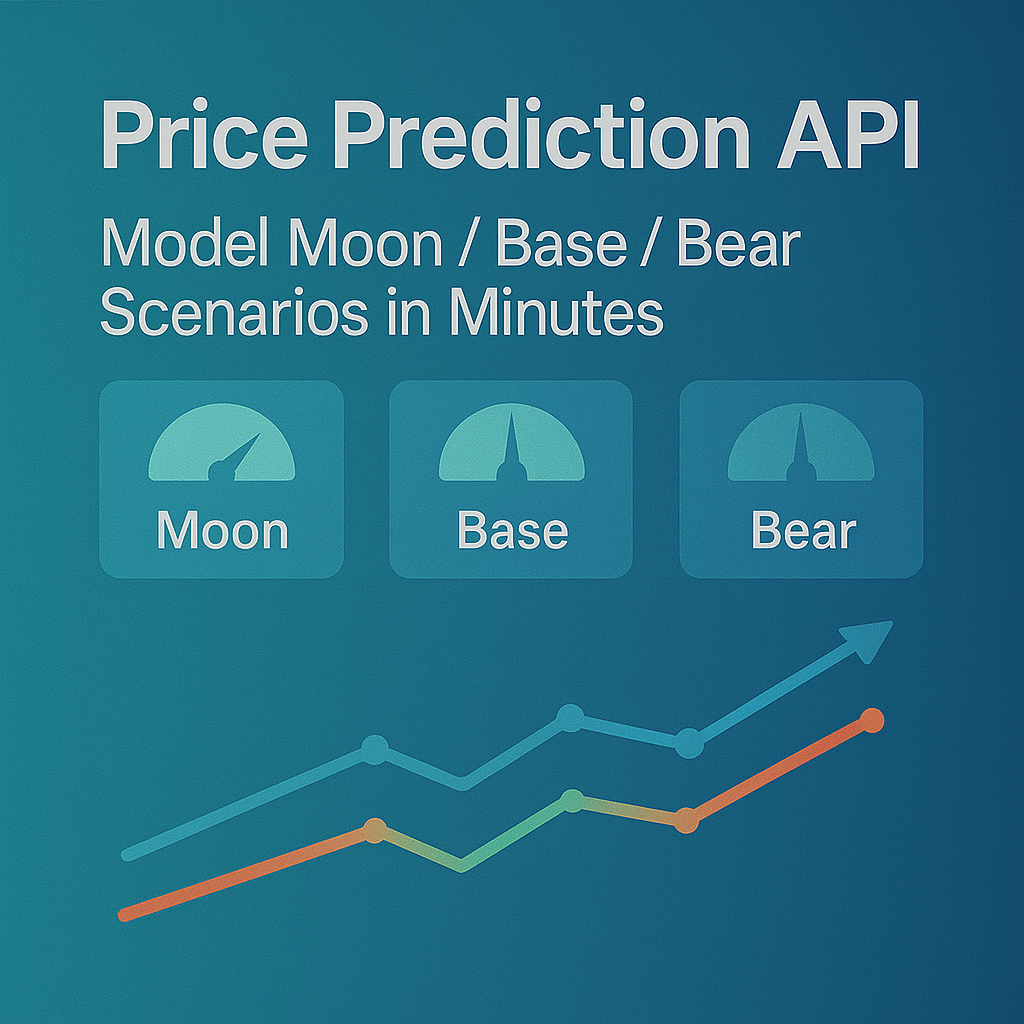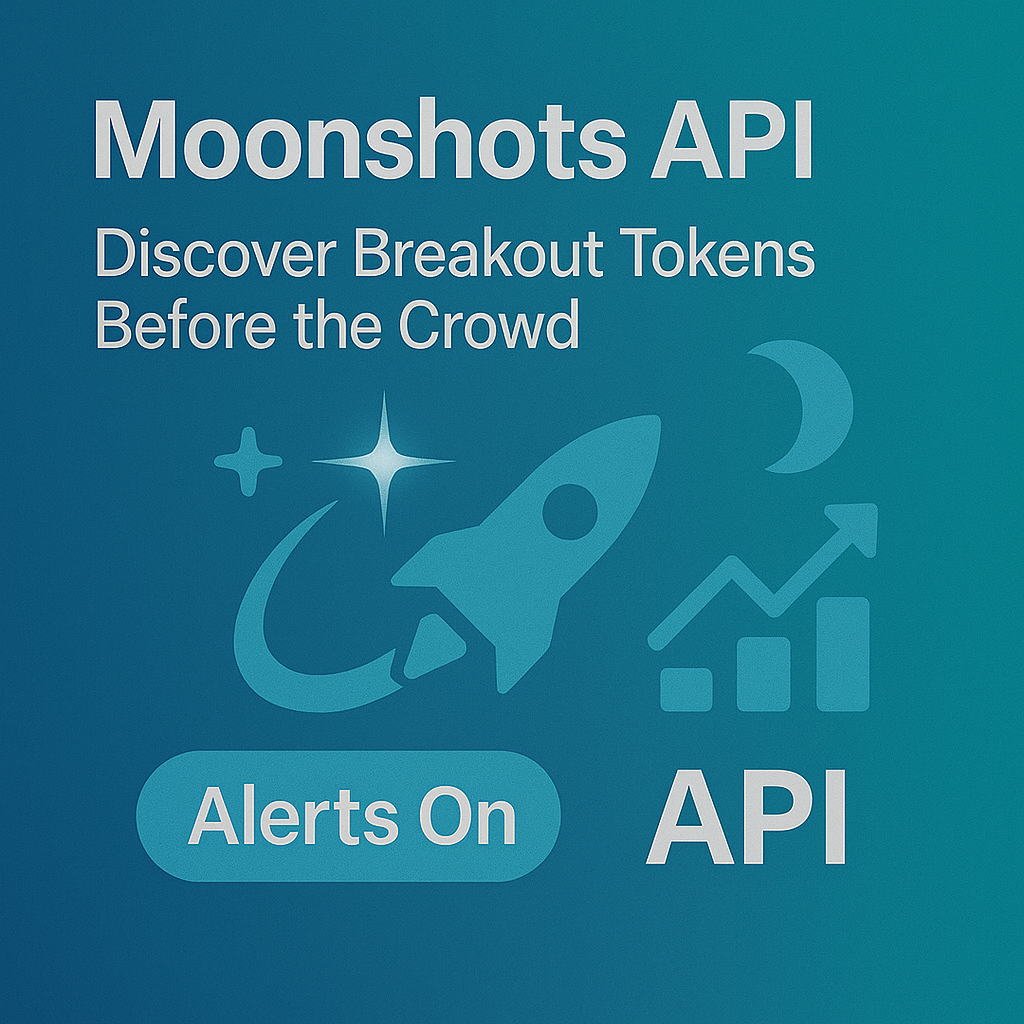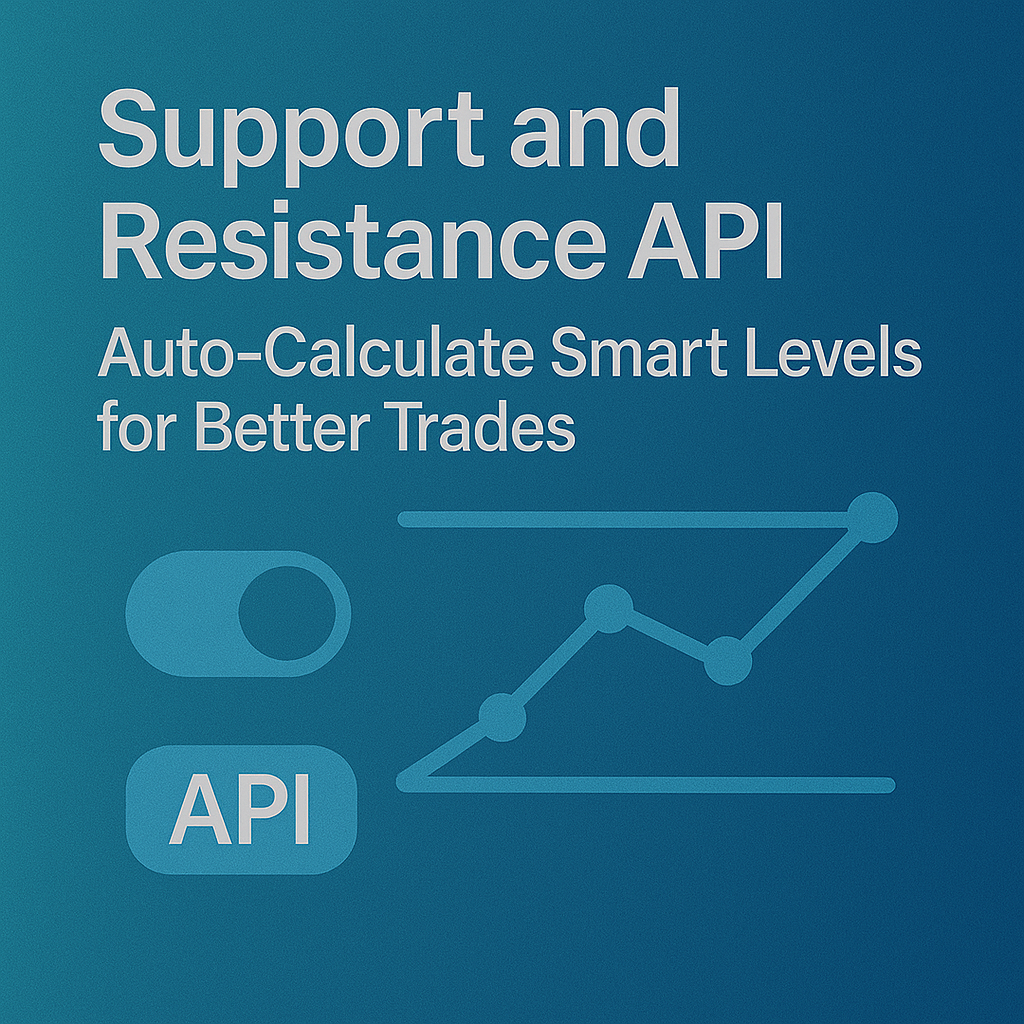Top Crypto Trading Platforms in 2025







%201.svg)
%201.svg)
Big news: We’re cranking up the heat on AI-driven crypto analytics with the launch of the Token Metrics API and our official SDK (Software Development Kit). This isn’t just an upgrade – it's a quantum leap, giving traders, hedge funds, developers, and institutions direct access to cutting-edge market intelligence, trading signals, and predictive analytics.
Crypto markets move fast, and having real-time, AI-powered insights can be the difference between catching the next big trend or getting left behind. Until now, traders and quants have been wrestling with scattered data, delayed reporting, and a lack of truly predictive analytics. Not anymore.
The Token Metrics API delivers 32+ high-performance endpoints packed with powerful AI-driven insights right into your lap, including:
Getting started with the Token Metrics API is simple:
At Token Metrics, we believe data should be decentralized, predictive, and actionable.
The Token Metrics API & SDK bring next-gen AI-powered crypto intelligence to anyone looking to trade smarter, build better, and stay ahead of the curve. With our official SDK, developers can plug these insights into their own trading bots, dashboards, and research tools – no need to reinvent the wheel.
%201.svg)
%201.svg)
The biggest gains in crypto rarely come from the majors. They come from Moonshots—fast-moving tokens with breakout potential. The Moonshots API surfaces these candidates programmatically so you can rank, alert, and act inside your product. In this guide, you’ll call /v2/moonshots, display a high-signal list with TM Grade and Bullish tags, and wire it into bots, dashboards, or screeners in minutes. Start by grabbing your key at Get API Key, then Run Hello-TM and Clone a Template to ship fast.
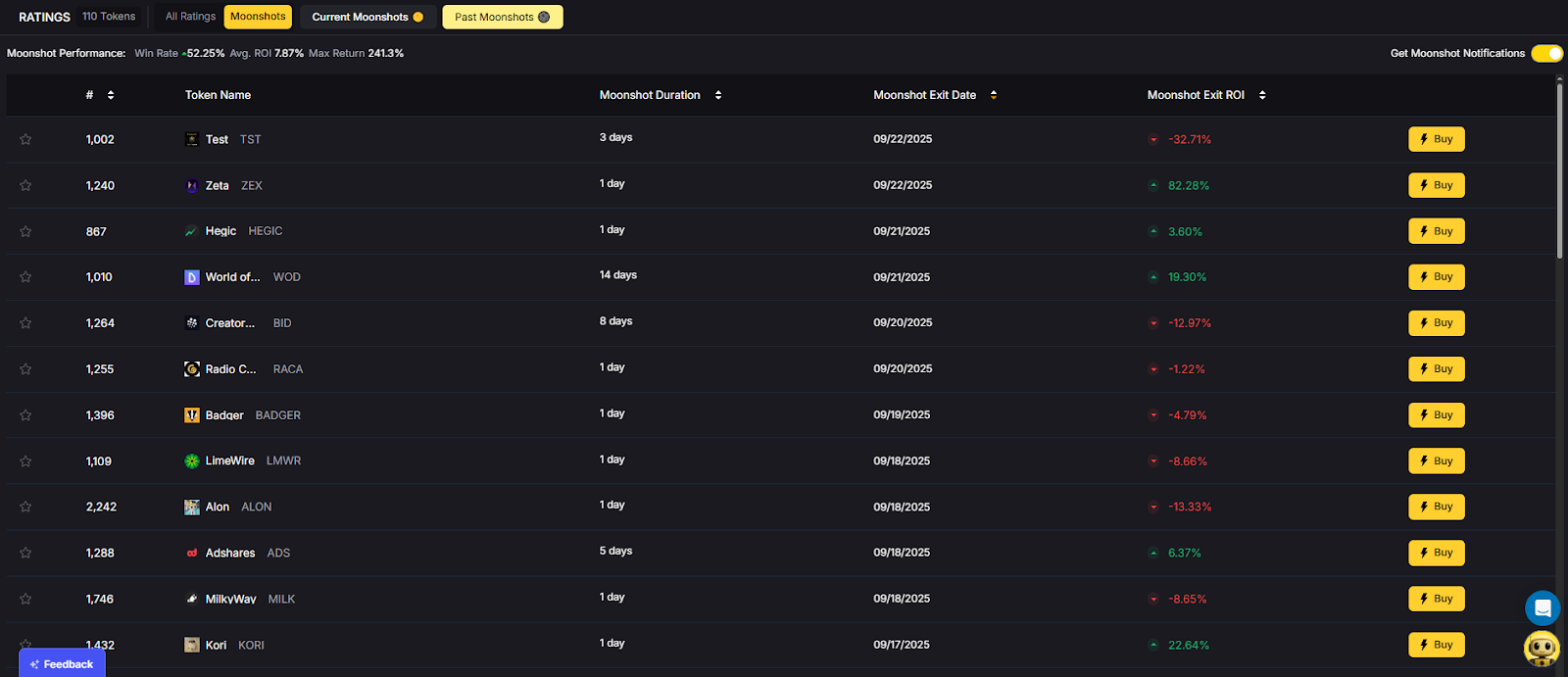
Discovery that converts. Users want more than price tickers—they want a curated, explainable list of high-potential tokens. The moonshots API encapsulates multiple signals into a short list designed for exploration, alerts, and watchlists you can monetize.
Built for builders. The endpoint returns a consistent schema with grade, signal, and context so you can immediately sort, badge, and trigger workflows. With predictable latency and clear filters, you can scale to dashboards, mobile apps, and headless bots without reinventing the discovery pipeline.
The Moonshots API cURL request is right there in the top right of the API Reference. Grab it and start tapping into the potential!
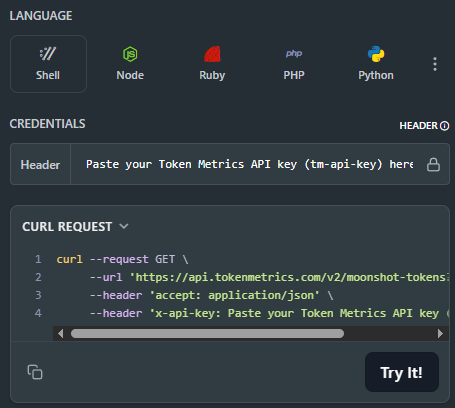
👉 Keep momentum: Get API Key • Run Hello-TM • Clone a Template
Fork a screener or alerting template, plug your key, and deploy. Validate your environment with Hello-TM. When you scale users or need higher limits, compare API plans.
The Moonshots endpoint aggregates a set of evidence—often combining TM Grade, signal state, and momentum/volume context—into a shortlist of breakout candidates. Each row includes a symbol, grade, signal, and timestamp, plus optional reason tags for transparency.
For UX, a common pattern is: headline list → token detail where you render TM Grade (quality), Trading Signals (timing), Support/Resistance (risk placement), Quantmetrics (risk-adjusted performance), and Price Prediction scenarios. This lets users understand why a token was flagged and how to act with risk controls.
Polling vs webhooks. Dashboards typically poll with short-TTL caching. Alerting flows use scheduled jobs or webhooks (where available) to smooth traffic and avoid duplicates. Always make notifications idempotent.
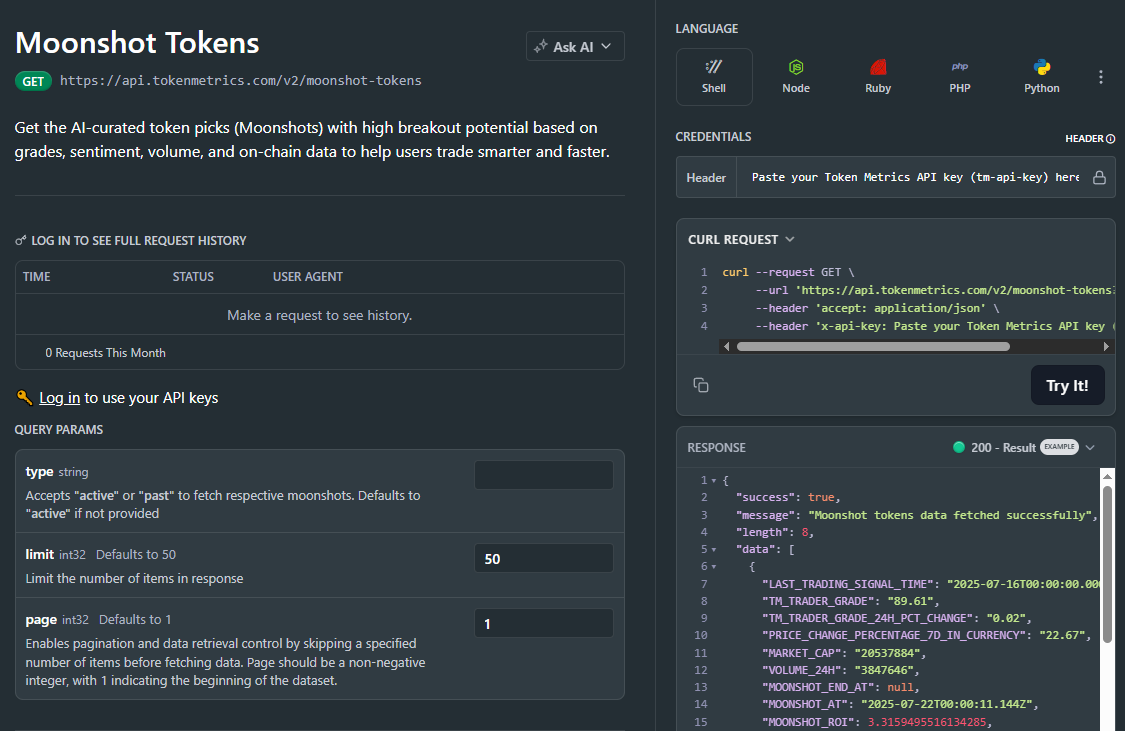
1) What does the Moonshots API return?
A list of breakout candidates with fields such as symbol, tm_grade, signal (often Bullish/Bearish), optional reason tags, and updated_at. Use it to drive discover tabs, alerts, and watchlists.
2) How fresh is the list? What about latency/SLOs?
The endpoint targets predictable latency and timely updates for dashboards and alerts. Use short-TTL caching and queued jobs/webhooks to avoid bursty polling.
3) How do I use Moonshots in a trading workflow?
Common stack: Moonshots for discovery, Trading Signals for timing, Support/Resistance for SL/TP, Quantmetrics for sizing, and Price Prediction for scenario context. Always backtest and paper-trade first.
4) I saw results like “+241%” and a “7.5% average return.” Are these guaranteed?
No. Any historical results are illustrative and not guarantees of future performance. Markets are risky; use risk management and testing.
5) Can I filter the Moonshots list?
Yes—pass parameters like min_grade, signal, and limit (as supported) to tailor to your audience and keep pages fast.
6) Do you provide SDKs or examples?
REST works with JavaScript and Python snippets above. Docs include quickstarts, Postman collections, and templates—start with Run Hello-TM.
7) Pricing, limits, and enterprise SLAs?
Begin free and scale up. See API plans for rate limits and enterprise options.
%201.svg)
%201.svg)
Most traders still draw lines by hand in TradingView. The support and resistance API from Token Metrics auto-calculates clean support and resistance levels from one request, so your dashboard, bot, or alerts can react instantly. In minutes, you’ll call /v2/resistance-support, render actionable levels for any token, and wire them into stops, targets, or notifications. Start by grabbing your key on Get API Key, then Run Hello-TM and Clone a Template to ship a production-ready feature fast.
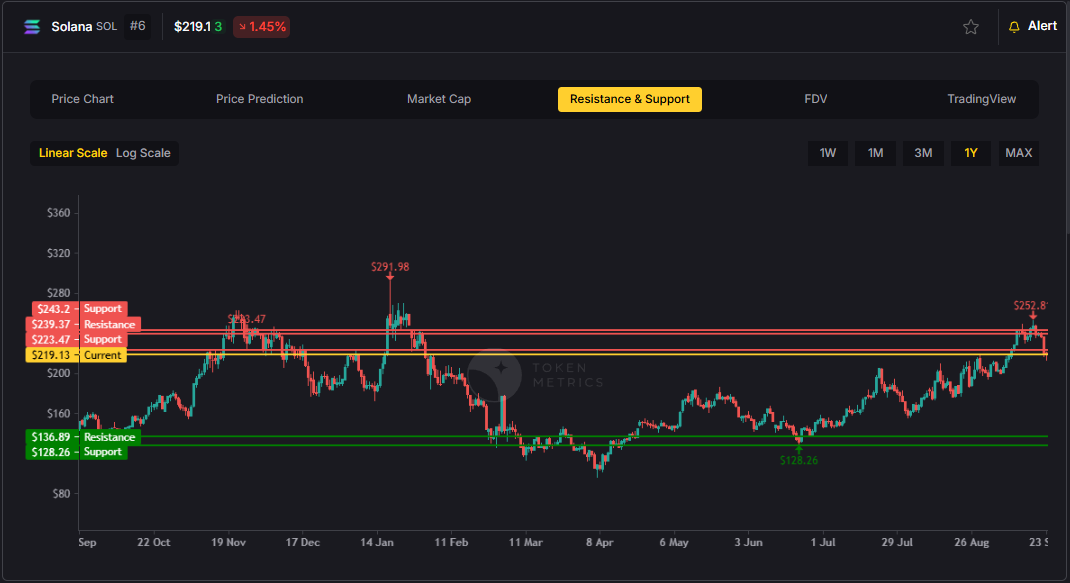
Precision beats guesswork. Hand-drawn lines are subjective and slow. The support and resistance API standardizes levels across assets and timeframes, enabling deterministic stops and take-profits your users (and bots) can trust.
Production-ready by design. A simple REST shape, predictable latency, and clear semantics let you add levels to token pages, automate SL/TP alerts, and build rule-based execution with minimal glue code.
Need the Support and Resistance data? The cURL request for it is in the top right of the API Reference for quick access.
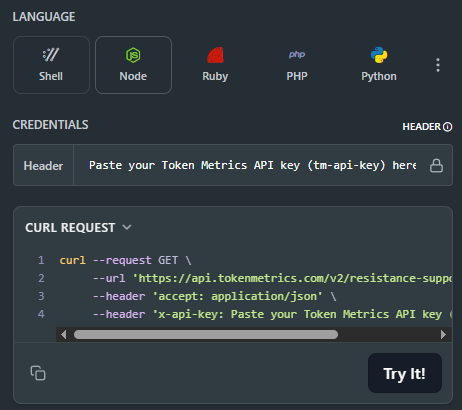
👉 Keep momentum: Get API Key • Run Hello-TM • Clone a Template
Kick off with our quickstarts—fork a bot or dashboard template, plug your key, and deploy. Confirm your environment by Running Hello-TM. When you’re scaling or need webhooks/limits, review API plans.
The Support/Resistance endpoint analyzes recent price structure to produce discrete levels above and below current price, along with strength indicators you can use for priority and styling. Query /v2/resistance-support?symbol=<ASSET>&timeframe=<HORIZON> to receive arrays of level objects and timestamps.
Polling vs webhooks. For dashboards, short-TTL caching and batched fetches keep pages snappy. For bots and alerts, use queued jobs or webhooks (where applicable) to avoid noisy, bursty polling—especially around market opens and major events.
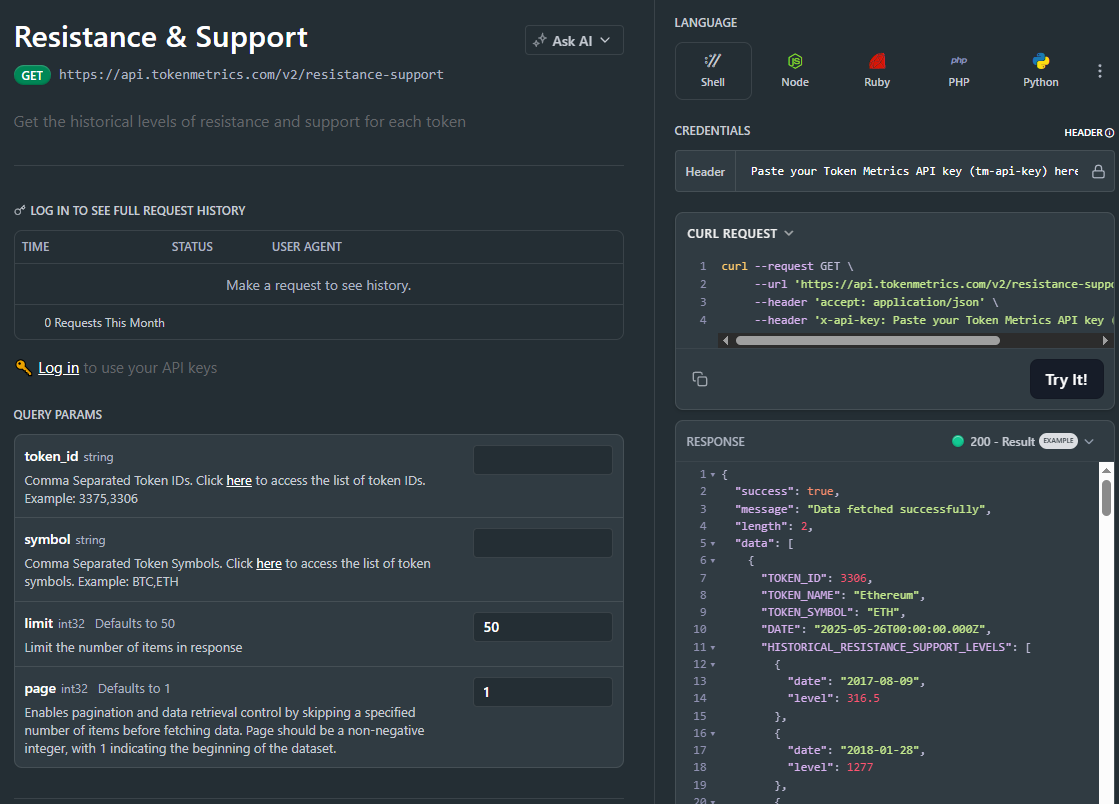
1) What does the Support & Resistance API return?
A JSON payload with arrays of support and resistance levels for a symbol (and optional timeframe), each with a price and strength indicator, plus an update timestamp.
2) How timely are the levels? What are the latency/SLOs?
The endpoint targets predictable latency suitable for dashboards and alerts. Use short-TTL caching for UIs, and queued jobs or webhooks for alerting to smooth traffic.
3) How do I trigger alerts or trades from levels?
Common patterns: alert when price is within X% of a level, touches a level, or breaks beyond with confirmation. Always make downstream actions idempotent and respect rate limits.
4) Can I combine levels with other endpoints?
Yes—pair with /v2/trading-signals for timing, /v2/tm-grade for quality context, and /v2/quantmetrics for risk sizing. This yields a complete decide-plan-execute loop.
5) Which timeframe should I use?
Intraday bots prefer shorter horizons; swing/position dashboards use daily or higher-timeframe levels. Offer a timeframe toggle and cache results per setting.
6) Do you provide SDKs or examples?
Use the REST snippets above (JS/Python). The docs include quickstarts, Postman collections, and templates—start with Run Hello-TM.
7) Pricing, limits, and enterprise SLAs?
Begin free and scale as you grow. See API plans for rate limits and enterprise SLA options.
%201.svg)
%201.svg)
Most traders see price—quants see probabilities. The Quantmetrics API turns raw performance into risk-adjusted stats like Sharpe, Sortino, volatility, drawdown, and CAGR so you can compare tokens objectively and build smarter bots and dashboards. In minutes, you’ll query /v2/quantmetrics, render a clear performance snapshot, and ship a feature that customers trust. Start by grabbing your key at Get API Key, Run Hello-TM to verify your first call, then Clone a Template to go live fast.
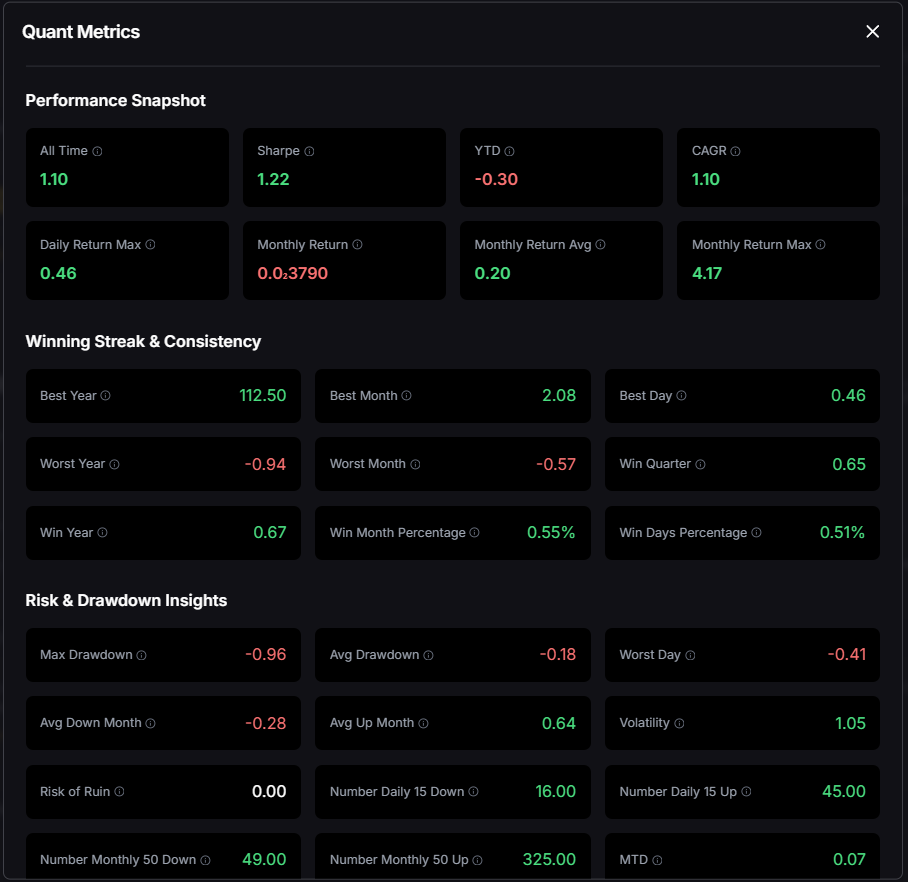
Risk-adjusted truth beats hype. Price alone hides tail risk and whipsaws. Quantmetrics compresses edge, risk, and consistency into metrics that travel across assets and timeframes—so you can rank universes, size positions, and communicate performance like a pro.
Built for dev speed. A clean REST schema, predictable latency, and easy auth mean you can plug Sharpe/Sortino into bots, dashboards, and screeners without maintaining your own analytics pipeline. Pair with caching and batching to serve fast pages at scale.
The Quant Metrics cURL request is located in the top right of the API Reference, allowing you to easily integrate it with your application.
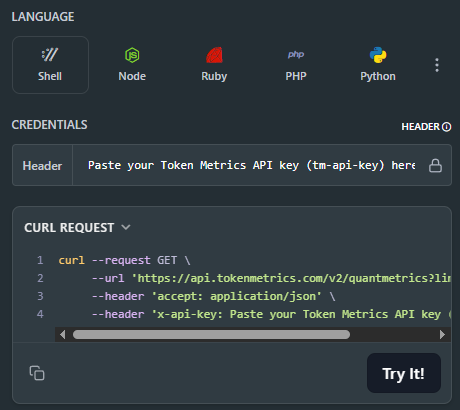
👉 Keep momentum: Get API Key • Run Hello-TM • Clone a Template
Kick off from quickstarts in the docs—fork a dashboard or screener template, plug your key, and deploy in minutes. Validate your environment with Run Hello-TM; when you need more throughput or webhooks, compare API plans.
Quantmetrics computes risk-adjusted performance over a chosen lookback (e.g., 30d, 90d, 1y). You’ll receive a JSON snapshot with core statistics:
Call /v2/quantmetrics?symbol=<ASSET>&window=<LOOKBACK> to fetch the current snapshot. For dashboards spanning many tokens, batch symbols and apply short-TTL caching. If you generate alerts (e.g., “Sharpe crossed 1.5”), run a scheduled job and queue notifications to avoid bursty polling.
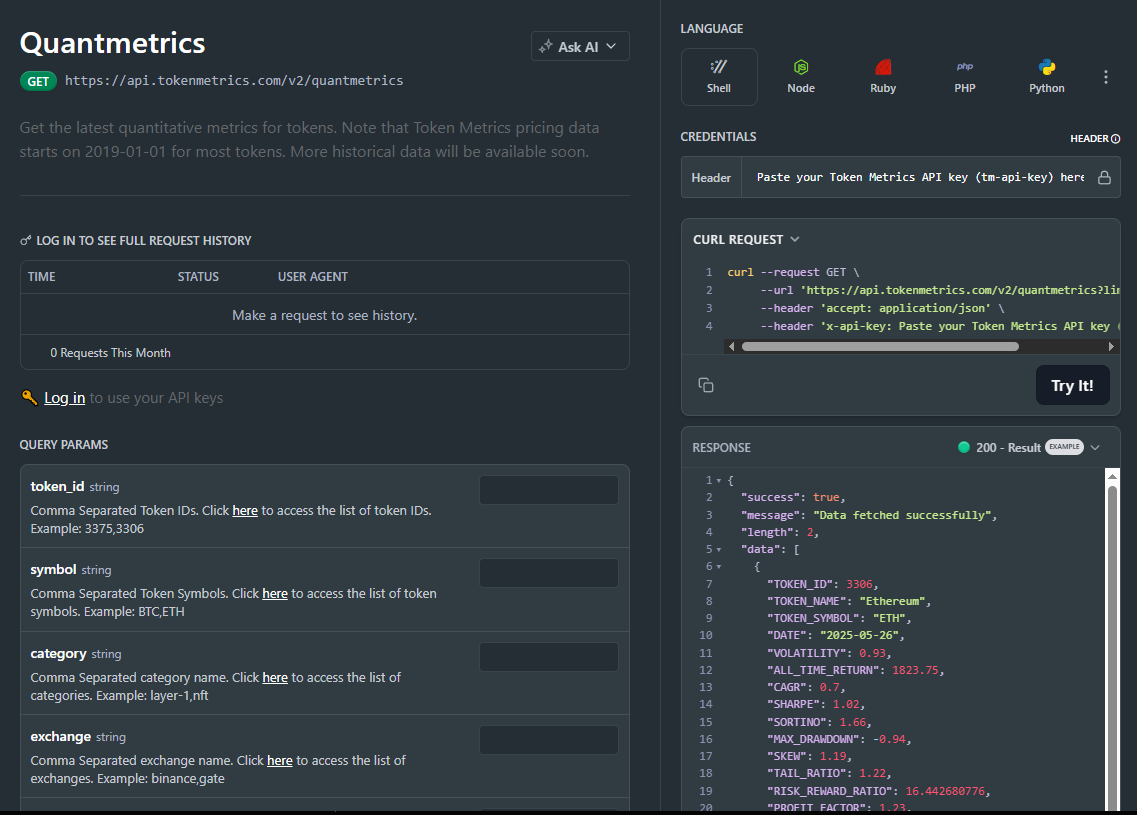
1) What does the Quantmetrics API return?
A JSON snapshot of risk-adjusted metrics (e.g., Sharpe, Sortino, volatility, max drawdown, CAGR) for a symbol and lookback window—ideal for ranking, sizing, and dashboards.
2) How fresh are the stats? What about latency/SLOs?
Responses are engineered for predictable latency. For heavy UI usage, add short-TTL caching and batch requests; for alerts, use scheduled jobs or webhooks where available.
3) Can I use Quantmetrics to size positions in a live bot?
Yes—many quants size inversely to volatility or require Sharpe ≥ X to trade. Always backtest and paper-trade before going live; past results are illustrative, not guarantees.
4) Which lookback window should I choose?
Short windows (30–90d) adapt faster but are noisier; longer windows (6–12m) are steadier but slower to react. Offer users a toggle and cache each window.
5) Do you provide SDKs or examples?
REST is straightforward (JS/Python above). Docs include quickstarts, Postman collections, and templates—start with Run Hello-TM.
6) Polling vs webhooks for quant alerts?
Dashboards usually use cached polling. For threshold alerts (e.g., Sharpe crosses 1.0), run scheduled jobs and queue notifications to keep usage smooth and idempotent.
7) Pricing, limits, and enterprise SLAs?
Begin free and scale up. See API plans for rate limits and enterprise SLA options.

%201.svg)
%201.svg)
APIs are the connective tissue of modern software. As organizations expose more endpoints to partners, internal teams and third-party developers, effective api management becomes a competitive and operational imperative. This article breaks down practical frameworks, governance guardrails, and monitoring strategies that help teams scale APIs securely and reliably without sacrificing developer velocity.
API management is the set of practices, tools and processes that enable teams to design, publish, secure, monitor and monetize application programming interfaces. At its core it addresses three recurring challenges: consistent access control, predictable performance, and discoverability for developers. Well-managed APIs reduce friction for consumers, decrease operational incidents, and support governance priorities such as compliance and data protection.
Think of api management as a lifecycle discipline: from design and documentation to runtime enforcement and iterative refinement. Organizations that treat APIs as products—measuring adoption, latency, error rates, and business outcomes—are better positioned to scale integrations without accumulating technical debt.
Security and governance are non-negotiable for production APIs. Implement a layered approach:
Combining automated policy enforcement at an API gateway with a governance framework (ownerable APIs, review gates, and versioning rules) ensures changes are controlled without slowing legitimate feature delivery.
Developer experience (DX) determines adoption. Treat APIs as products by providing clear documentation, SDKs and a self-service developer portal. Key practices include:
Metrics to track DX include signups, first successful call time, and repeat usage per key. These are leading indicators of whether an API is fulfilling its product intent.
Operational visibility is essential for api management. Implement monitoring at multiple layers—gateway, service, and database—to triangulate causes when issues occur. Core telemetry includes:
Observability practices—distributed tracing, structured logs, and context propagation—help teams move from alert fatigue to actionable incident response. Build runbooks that map common alerts to remediation steps and owners.
Adopt an incremental roadmap rather than a big-bang rollout. A pragmatic sequence looks like:
Choose tools that match team maturity: managed API platforms accelerate setup for companies lacking infra resources, while open-source gateways provide control for those with specialized needs. Evaluate vendors on extensibility, observability integrations, and policy-as-code support to avoid lock-in.
Build Smarter Crypto Apps & AI Agents with Token Metrics
Token Metrics provides real-time prices, trading signals, and on-chain insights all from one powerful API. Grab a Free API Key
API management encompasses the processes and tools required to publish, secure, monitor, and monetize APIs. It matters because it enables predictable, governed access to services while maintaining developer productivity and operational reliability.
Common components include an API gateway (auth, routing, rate limiting), developer portal (docs, keys), analytics and monitoring systems (metrics, traces), and lifecycle tooling (design, versioning, CI/CD integrations).
Implement defense-in-depth: centralized authentication, token validation, input schema checks, rate limits, and continuous auditing. Shift security left by validating contracts and scanning specs before deployment.
Track latency percentiles, error rates, traffic patterns, and consumer-specific usage. Pair operational metrics with business KPIs (e.g., API-driven signups) to prioritize work that affects outcomes.
Use explicit versioning, deprecation windows, and dual-running strategies where consumers migrate incrementally. Communicate changes via the developer portal and automated notifications tied to API keys.
Introduce a gateway early when multiple consumers, partners, or internal teams rely on APIs. A gateway centralizes cross-cutting concerns and reduces duplicated security and routing logic.
This article is for educational and informational purposes only. It provides neutral, analytical information about api management practices and tools and does not constitute professional or investment advice.

%201.svg)
%201.svg)
APIs are the connective tissue of modern software: they expose functionality, move data, and enable integrations across services, devices, and platforms. A well-designed web API shapes developer experience, system resilience, and operational cost. This article breaks down core concepts, common architectures, security and observability patterns, and practical steps to build and maintain reliable web APIs without assuming a specific platform or vendor.
A web API (Application Programming Interface) is an HTTP-accessible interface that lets clients interact with server-side functionality. APIs can return JSON, XML, or other formats and typically define a contract of endpoints, parameters, authentication requirements, and expected responses. They matter because they enable modularity: front-ends, mobile apps, third-party integrations, and automation tools can all reuse the same backend logic.
When evaluating or designing an API, consider the consumer experience: predictable endpoints, clear error messages, consistent versioning, and comprehensive documentation reduce onboarding friction for integrators. Think of an API as a public product: its usability directly impacts adoption and maintenance burden.
There are several architectural approaches to web APIs. RESTful (resource-based) design emphasizes nouns and predictable HTTP verbs. GraphQL centralizes query flexibility into a single endpoint and lets clients request only the fields they need. gRPC is used for low-latency, binary RPC between services.
Key design practices:
Choose the pattern that aligns with your performance, flexibility, and developer ergonomics goals, and make that decision explicit in onboarding docs.
Security must be built into an API from day one. Common controls include TLS for transport, OAuth 2.0 / OpenID Connect for delegated authorization, API keys for service-to-service access, and fine-grained scopes for least-privilege access. Input validation, output encoding, and strict CORS policies guard against common injection and cross-origin attacks.
Operational protections such as rate limiting, quotas, and circuit breakers help preserve availability if a client misbehaves or a downstream dependency degrades. Design your error responses to be informative to developers but avoid leaking internal implementation details. Centralized authentication and centralized secrets management (vaults, KMS) reduce duplication and surface area for compromise.
Performance considerations span latency, throughput, and resource efficiency. Use caching (HTTP cache headers, CDN, or in-memory caches) to reduce load on origin services. Employ pagination, partial responses, and batch endpoints to avoid overfetching. Instrumentation is essential: traces, metrics, and logs help correlate symptoms, identify bottlenecks, and measure SLAs.
Testing should be layered: unit tests for business logic, contract tests against API schemas, integration tests for end-to-end behavior, and load tests that emulate real-world usage. Observability tools and APMs provide continuous insight; AI-driven analytics platforms such as Token Metrics can help surface unusual usage patterns and prioritize performance fixes based on impact.
Build Smarter Crypto Apps & AI Agents with Token Metrics
Token Metrics provides real-time prices, trading signals, and on-chain insights all from one powerful API. Grab a Free API Key
REST exposes multiple endpoints that represent resources and rely on HTTP verbs for operations. It is simple and maps well to HTTP semantics. GraphQL exposes a single endpoint where clients request precisely the fields they need, which reduces overfetching and can simplify mobile consumption. GraphQL adds complexity in query planning and caching; choose based on client needs and team expertise.
Prefer backward-compatible changes over breaking changes. Use semantic versioning for major releases, and consider header-based versioning or URI version prefixes when breaking changes are unavoidable. Maintain deprecation schedules and communicate timelines in documentation and response headers so clients can migrate predictably.
OAuth 2.0 and OpenID Connect are standard for delegated access and single-sign-on. For machine-to-machine communication, use short-lived tokens issued by a trusted authorization server. API keys can be simple to implement but should be scoped, rotated regularly, and never embedded in public clients without additional protections.
Implement synthetic monitoring for critical endpoints, collect real-user metrics (latency percentiles, error rates), and instrument distributed tracing to follow requests across services. Run scheduled contract tests against staging and production-like environments, and correlate incidents with deployment timelines and dependency health.
Make additive, non-breaking changes where possible: add new fields rather than changing existing ones, and preserve default behaviors. Document deprecated fields and provide feature flags to gate new behavior. Maintain versioned client libraries to give consumers time to upgrade.
Disclaimer
This article is educational and technical in nature. It does not provide legal, financial, or investment advice. Implementations should be evaluated with respect to security policies, compliance requirements, and operational constraints specific to your organization.

%201.svg)
%201.svg)
APIs power modern software by exposing discrete access points called endpoints. Whether you re integrating a third-party data feed, building a microservice architecture, or wiring a WebSocket stream, understanding what an api endpoint is and how to design, secure, and monitor one is essential for robust systems.
An api endpoint is a network-accessible URL or address that accepts requests and returns responses according to a protocol (usually HTTP/HTTPS or WebSocket). Conceptually, an endpoint maps a client intent to a server capability: retrieve a resource, submit data, or subscribe to updates. In a RESTful API, endpoints often follow noun-based paths (e.g., /users/123) combined with HTTP verbs (GET, POST, PUT, DELETE) to indicate the operation.
Key technical elements of an endpoint include:
Endpoints can be public (open to third parties) or private (internal to a service mesh). For crypto-focused data integrations, api endpoints may also expose streaming interfaces (WebSockets) or webhook callbacks for asynchronous events. For example, Token Metrics is an example of an analytics provider that exposes APIs for research workflows.
Different application needs favor different endpoint types and protocols:
Choosing a protocol depends on consistency requirements, latency tolerance, and client diversity. Hybrid architectures often combine REST for configuration and GraphQL/WebSocket for dynamic data.
Good endpoint design improves developer experience and system resilience. Follow these practical practices:
API schema tools (OpenAPI/Swagger, AsyncAPI) let you define endpoints, types, and contracts programmatically, enabling automated client generation, testing, and mock servers during development.
Endpoints are primary attack surfaces. Security and observability are critical:
Operational tooling such as API gateways, service meshes, and managed API platforms provide built-in policy enforcement for security and rate limiting, reducing custom code complexity.
Build Smarter Crypto Apps & AI Agents with Token Metrics
Token Metrics provides real-time prices, trading signals, and on-chain insights all from one powerful API. Grab a Free API Key
An API is the overall contract and set of capabilities a service exposes; an api endpoint is a specific network address (URI) where one of those capabilities is accessible. Think of the API as the menu and endpoints as the individual dishes.
Use HTTPS only, require authenticated tokens with appropriate scopes, implement rate limits and IP reputation checks, and validate all input. Employ monitoring to detect anomalous traffic patterns and rotate credentials periodically.
Introduce explicit versioning when you plan to make breaking changes to request/response formats or behavior. Semantic versioning in the path (e.g., /v1/) is common and avoids forcing clients to adapt unexpectedly.
Combine per-key quotas, sliding-window or token-bucket algorithms, and burst allowances. Communicate limits via response headers and provide clear error codes and retry-after values so clients can back off gracefully.
Track request rate (RPS), error rate (4xx/5xx), latency percentiles (p50, p95, p99), and active connections for streaming endpoints. Correlate with upstream/downstream service metrics to identify root causes.
Choose GraphQL when clients require flexible field selection and you want to reduce overfetching. Prefer REST for simple resource CRUD patterns and when caching intermediaries are important. Consider team familiarity and tooling ecosystem as well.
The information in this article is technical and educational in nature. It is not financial, legal, or investment advice. Implementations should be validated in your environment and reviewed for security and compliance obligations specific to your organization.

%201.svg)
%201.svg)
Modern web and mobile apps exchange data constantly. At the center of that exchange is the REST API — a widely adopted architectural style that standardizes how clients and servers communicate over HTTP. Whether you are a developer, product manager, or researcher, understanding what a REST API is and how it works is essential for designing scalable systems and integrating services efficiently.
A REST API (Representational State Transfer Application Programming Interface) is a style for designing networked applications. It defines a set of constraints that, when followed, enable predictable, scalable, and loosely coupled interactions between clients (browsers, mobile apps, services) and servers. REST is not a protocol or standard; it is a set of architectural principles introduced by Roy Fielding in 2000.
Key principles include:
A REST API organizes functionality around resources and uses standard HTTP verbs to manipulate them. Common conventions are:
Responses use HTTP status codes to indicate result state (200 OK, 201 Created, 204 No Content, 400 Bad Request, 401 Unauthorized, 404 Not Found, 500 Internal Server Error). Payloads are typically JSON but can be XML or other formats. Endpoints are structured hierarchically, for example: /api/users to list users, /api/users/123 to operate on user with ID 123.
Designing a robust REST API involves more than choosing verbs and URIs. Adopt patterns that make APIs understandable, maintainable, and secure:
Following these practices improves interoperability and reduces operational risk.
REST APIs are used across web services, microservices, mobile backends, IoT devices, and third-party integrations. Developers commonly use tools and practices to build and validate APIs:
AI-driven platforms and analytics can speed research and debugging by surfacing usage patterns, anomalies, and integration opportunities. For example, Token Metrics can be used to analyze API-driven data feeds and incorporate on-chain signals into application decision layers without manual data wrangling.
Build Smarter Crypto Apps & AI Agents with Token Metrics
Token Metrics provides real-time prices, trading signals, and on-chain insights all from one powerful API. Grab a Free API Key
"REST" refers to the architectural constraints described by Roy Fielding; "RESTful" is a colloquial adjective meaning an API that follows REST principles. Not all APIs labeled RESTful implement every REST constraint strictly.
SOAP is a protocol with rigid standards and built-in operations (often used in enterprise systems). GraphQL exposes a single endpoint and lets clients request precise data shapes. REST uses multiple endpoints and standard HTTP verbs. Each approach has trade-offs in flexibility, caching, and tooling.
Version your API before making breaking changes to request/response formats or behavior that existing clients depend on. Common strategies include URI versioning (e.g., /v1/) or header-based versioning.
No. Security must be designed in: use HTTPS/TLS, authenticate requests, validate input, apply authorization checks, and limit rate to reduce abuse. Treat REST APIs like any other public interface that requires protection.
Use API specifications (OpenAPI) to auto-generate docs and client stubs. Combine manual testing tools like Postman with automated integration and contract tests in CI pipelines to ensure consistent behavior across releases.
REST is request/response oriented and not ideal for continuous real-time streams. For streaming, consider WebSockets, Server-Sent Events (SSE), or specialized protocols; REST can still be used for control operations and fallbacks.
Disclaimer: This article is educational and technical in nature. It does not provide investment or legal advice. The information is intended to explain REST API concepts and best practices, not to recommend specific products or actions.

%201.svg)
%201.svg)
FastAPI has become a go-to framework for teams that need production-ready, high-performance APIs in Python. It combines modern Python features, automatic type validation via pydantic, and ASGI-based async support to deliver low-latency endpoints. This post breaks down pragmatic patterns for building, testing, and scaling FastAPI services, with concrete guidance on performance tuning, deployment choices, and observability so you can design robust APIs for real-world workloads.
FastAPI is an ASGI framework that emphasizes developer experience and runtime speed. It generates OpenAPI docs automatically, enforces request/response typing, and integrates cleanly with async workflows. Compare FastAPI to traditional WSGI stacks (Flask, Django sync endpoints): FastAPI excels when concurrency and I/O-bound tasks dominate, and when you want built-in validation and schema-driven design.
Use-case scenarios where FastAPI shines:
FastAPI leverages async/await to let a single worker handle many concurrent requests when operations are I/O-bound. Key principles:
Performance tuning checklist:
FastAPI's dependency injection and pydantic models enable clear separation of concerns. Recommended practices:
Scenario analysis: for CPU-bound workloads (e.g., heavy data processing), prefer external workers or serverless functions. For high-concurrency I/O-bound workloads, carefully tuned async endpoints perform best.
Deploying FastAPI requires choices around containers, orchestration, and observability:
CI/CD tips: include a test matrix for schema validation, contract tests against OpenAPI, and canary deploys for backward-incompatible changes.
Build Smarter Crypto Apps & AI Agents with Token Metrics
Token Metrics provides real-time prices, trading signals, and on-chain insights all from one powerful API. Grab a Free API Key
FastAPI is a modern, ASGI-based Python framework focused on speed and developer productivity. It differs from traditional frameworks by using type hints for validation, supporting async endpoints natively, and automatically generating OpenAPI documentation.
Prefer async endpoints for I/O-bound operations like network calls or async DB drivers. If your code is CPU-bound, spawning background workers or using synchronous workers with more processes may be better to avoid blocking the event loop.
There is no one-size-fits-all. Start with CPU core count as a baseline and adjust based on latency and throughput measurements. For async I/O-bound workloads, fewer workers with higher concurrency can be more efficient; for blocking workloads, increase worker count or externalize tasks.
Enforce strong input validation with pydantic, use HTTPS, validate and sanitize user data, implement authentication and authorization (OAuth2, JWT), and apply rate limiting and request size limits at the gateway.
Use TestClient from FastAPI for unit and integration tests, mock external dependencies, write contract tests against OpenAPI schemas, and include load tests in CI to catch performance regressions early.
This article is for educational purposes only. It provides technical and operational guidance for building APIs with FastAPI and does not constitute professional or financial advice.

%201.svg)
%201.svg)
APIs are the connective tissue of modern software. Testing them thoroughly prevents regressions, ensures predictable behavior, and protects downstream systems. This guide breaks API testing into practical steps, frameworks, and tool recommendations so engineers can build resilient interfaces and integrate them into automated delivery pipelines.
API testing verifies that application programming interfaces behave according to specification: returning correct data, enforcing authentication and authorization, handling errors, and performing within expected limits. Unlike UI testing, API tests focus on business logic, data contracts, and integration between systems rather than presentation. Well-designed API tests are fast, deterministic, and suitable for automation, enabling rapid feedback in development workflows.
Effective strategies balance scope, speed, and confidence. A common model is the testing pyramid: many fast unit tests, a moderate number of integration and contract tests, and fewer end-to-end or performance tests. Core elements of a robust strategy include:
Tooling choices depend on protocols (REST, GraphQL, gRPC) and language ecosystems. Common tools and patterns include:
Automation should be baked into CI/CD pipelines: run unit and contract tests on pull requests, integration tests on feature branches or merged branches, and schedule performance/security suites on staging environments. Observability during test runs—collecting metrics, logs, and traces—helps diagnose flakiness and resource contention faster.
AI-driven analysis can accelerate test coverage and anomaly detection by suggesting high-value test cases and highlighting unusual response patterns. For teams that integrate external data feeds into their systems, services that expose robust, real-time APIs and analytics can be incorporated into test scenarios to validate third-party integrations under realistic conditions. For example, Token Metrics offers datasets and signals that can be used to simulate realistic inputs or verify integrations with external data providers.
Build Smarter Crypto Apps & AI Agents with Token Metrics
Token Metrics provides real-time prices, trading signals, and on-chain insights all from one powerful API. Grab a Free API Key
Unit tests isolate individual functions or routes using mocks and focus on internal logic. Integration tests exercise multiple components together (for example service + database) to validate interaction, data flow, and external dependencies.
Run lightweight load tests during releases and schedule comprehensive performance runs on staging before major releases or after architecture changes. Frequency depends on traffic patterns and how often critical paths change.
AI can suggest test inputs, prioritize test cases by risk, detect anomalies in responses, and assist with test maintenance through pattern recognition. Treat AI as a productivity augmenter that surfaces hypotheses requiring engineering validation.
Contract testing ensures providers and consumers agree on the API contract (schemas, status codes, semantics). It reduces integration regressions by failing early when expectations diverge, enabling safer deployments in distributed systems.
Use deterministic fixtures, isolate test databases, anonymize production data when necessary, seed environments consistently, and prefer schema or contract assertions to validate payload correctness rather than brittle value expectations.
Investigate root causes such as timing, external dependencies, or resource contention. Reduce flakiness by mocking unstable third parties, improving environment stability, adding idempotent retries where appropriate, and capturing diagnostic traces during failures.
This article is educational and technical in nature and does not constitute investment, legal, or regulatory advice. Evaluate tools and data sources independently and test in controlled environments before production use.

%201.svg)
%201.svg)
APIs power modern software by letting systems communicate without exposing internal details. Whether you're building an AI agent, integrating price feeds for analytics, or connecting wallets, understanding the core concept of an "API" — and the practical rules around using one — is essential. This article defines what an API is, explains common types, highlights evaluation criteria, and outlines best practices for secure, maintainable integrations.
API stands for Application Programming Interface. At its simplest, an API is a contract: a set of rules that lets one software component request data or services from another. The contract specifies available endpoints (or methods), required inputs, expected outputs, authentication requirements, and error semantics. APIs abstract implementation details so consumers can depend on a stable surface rather than internal code.
Think of an API as a menu in a restaurant: the menu lists dishes (endpoints), describes ingredients (parameters), and sets expectations for what arrives at the table (responses). Consumers don’t need to know how the kitchen prepares the dishes — only how to place an order.
APIs come in several architectural styles. The three most common today are:
Choosing a style depends on use case: REST for simple, cacheable resources; GraphQL for complex client-driven queries; gRPC/WebSocket for low-latency or streaming scenarios.
Documentation quality often determines integration time and reliability. When evaluating an API, check for:
For crypto and market data APIs, also verify the latency SLAs, the freshness of on‑chain reads, and whether historical data is available in a form suitable for research or model training.
APIs expose surface area; securing that surface is critical. Key practices include:
Security and resilience are especially important in finance and crypto environments where integrity and availability directly affect analytics and automated systems.
APIs are central to AI-driven research and crypto tooling. When integrating APIs into data pipelines or agent workflows, consider these steps:
AI models and agents can benefit from structured, versioned APIs that provide deterministic responses; integrating dataset provenance and schema validation improves repeatability in experiments.
Build Smarter Crypto Apps & AI Agents with Token Metrics
Token Metrics provides real-time prices, trading signals, and on-chain insights all from one powerful API. Grab a Free API Key
An API is an interface that defines how two software systems communicate. It lists available operations, required inputs, and expected outputs so developers can use services without understanding internal implementations.
REST exposes fixed resource endpoints and relies on HTTP semantics. GraphQL exposes a flexible query language letting clients fetch precise fields in one request. REST favors caching and simplicity; GraphQL favors efficiency for complex client queries.
Confirm data freshness, historical coverage, authentication methods, rate limits, and the provider’s documentation. Also verify uptime, SLA terms if relevant, and whether the API provides proof or verifiable on‑chain reads for critical use cases.
Rate limits set a maximum number of requests per time window, often per API key or IP. Providers may return headers indicating remaining quota and reset time; implement exponential backoff and caching to stay within limits.
AI-driven research tools can summarize documentation, detect breaking changes, and suggest integration patterns. For provider-specific signals and token research, platforms like Token Metrics combine multiple data sources and models to support analysis workflows.
This article is educational and informational only. It does not constitute financial, legal, or investment advice. Readers should perform independent research and consult qualified professionals before making decisions related to finances, trading, or technical integrations.

%201.svg)
%201.svg)
Modern distributed systems rely on effective traffic control, security, and observability at the edge. An API gateway centralizes those responsibilities, simplifying client access to microservices and serverless functions. This guide explains what an API gateway does, common architectural patterns, deployment and performance trade-offs, and design best practices for secure, scalable APIs.
An API gateway is a server-side component that sits between clients and backend services. It performs request routing, protocol translation, aggregation, authentication, rate limiting, and metrics collection. Instead of exposing each service directly, teams present a single, consolidated API surface to clients through the gateway. This centralization reduces client complexity, standardizes cross-cutting concerns, and can improve operational control.
Think of an API gateway as a policy and plumbing layer: it enforces API contracts, secures endpoints, and implements traffic shaping while forwarding requests to appropriate services.
API gateways vary in capability but commonly include:
Common patterns include:
Choosing where and how to deploy an API gateway affects performance, resilience, and operational cost. Key models include:
Performance trade-offs to monitor:
Adopt practical rules to keep gateways maintainable and secure:
AI and analytics tools can accelerate gateway design and operating decisions by surfacing traffic patterns, anomaly detection, and vulnerability signals. For example, products that combine real-time telemetry with model-driven insights help prioritize which endpoints need hardened policies.
Build Smarter Crypto Apps & AI Agents with Token Metrics
Token Metrics provides real-time prices, trading signals, and on-chain insights all from one powerful API. Grab a Free API Key
These technologies complement rather than replace each other. The API gateway handles north-south traffic (client to cluster), enforcing authentication and exposing public endpoints. A service mesh focuses on east-west traffic (service-to-service), offering fine-grained routing, mTLS, and telemetry between microservices. Many architectures use a gateway at the edge and a mesh internally for granular control.
A gateway introduces processing overhead for each request, which can increase end-to-end latency. Mitigations include optimizing filters, enabling HTTP/2 multiplexing, using local caches, and scaling gateway instances horizontally.
Not always. Small monoliths or single-service deployments may not require a gateway. For microservices, public APIs, or multi-tenant platforms, a gateway adds value by centralizing cross-cutting concerns and simplifying client integrations.
At minimum, the gateway should enforce TLS, validate authentication tokens, apply rate limits, and perform input validation. Additional controls include IP allowlists, web application firewall (WAF) rules, and integration with identity providers for RBAC.
Yes. Aggregation reduces client round trips by composing responses from multiple backends. Use caching and careful error handling to avoid coupling performance of one service to another.
Use a staging environment to run synthetic loads and functional tests against gateway policies. Store configurations in version control, run CI checks for syntax and policy conflicts, and roll out changes via canary deployments.
Managed gateways reduce operational overhead and provide scalability out of the box, while self-hosted gateways offer deeper customization and potentially lower long-term costs. Choose based on team expertise, compliance needs, and expected traffic patterns.
This article is for educational and technical information only. It does not constitute investment, legal, or professional advice. Readers should perform their own due diligence when selecting and configuring infrastructure components.

%201.svg)
%201.svg)
APIs are the connective tissue of modern applications; among them, RESTful APIs remain a dominant style because they map cleanly to HTTP semantics and scale well across distributed systems. This article breaks down what a RESTful API is, pragmatic design patterns, security controls, and practical monitoring and testing workflows. If you build or consume APIs, understanding these fundamentals reduces integration friction and improves reliability.
A RESTful API (Representational State Transfer) is an architectural style for designing networked applications. At its core, REST leverages standard HTTP verbs (GET, POST, PUT, PATCH, DELETE) and status codes to perform operations on uniquely identified resources, typically represented as URLs. Key characteristics include:
REST is a pragmatic guideline rather than a strict protocol; many APIs labeled "RESTful" adopt REST principles while introducing pragmatic extensions (e.g., custom headers, versioning strategies).
Good REST design begins with clear resource modeling. Ask: what are the nouns in the domain, and how do they relate? Use predictable URL structures and rely on HTTP semantics:
Design tips to improve usability and longevity:
Security is a primary concern for any public-facing API. Typical controls and patterns include:
Designing for security also means operational readiness: automated certificate rotation, secrets management, and periodic security reviews reduce long-term risk.
Performance tuning for RESTful APIs covers latency, throughput, and reliability. Practical strategies include caching (HTTP Cache-Control, ETags), connection pooling, and database query optimization. Use observability tools to collect metrics (error rates, latency percentiles), distributed traces, and structured logs for rapid diagnosis.
AI-assisted tools can accelerate many aspects of API development and operations: anomaly detection in request patterns, automated schema inference from traffic, and intelligent suggestions for endpoint design or documentation. While these tools improve efficiency, validate automated changes through testing and staged rollouts.
When selecting tooling, evaluate clarity of integrations, support for your API architecture, and the ability to export raw telemetry for custom analysis.
Build Smarter Crypto Apps & AI Agents with Token Metrics
Token Metrics provides real-time prices, trading signals, and on-chain insights all from one powerful API. Grab a Free API Key
REST focuses on resources and uses HTTP semantics; GraphQL centralizes queries into a single endpoint with flexible queries, and gRPC emphasizes high-performance RPCs with binary protocols. Choose based on client needs, performance constraints, and schema evolution requirements.
Common approaches include URL versioning (e.g., /v1/), header-based versioning, or semantic versioning of the API contract. Regardless of method, document deprecation timelines and provide migration guides and compatibility layers where possible.
Combine unit tests for business logic with integration tests that exercise endpoints and mocks for external dependencies. Use contract tests to ensure backward compatibility and end-to-end tests in staging environments. Automate tests in CI/CD to catch regressions early.
Additive changes (new fields, endpoints) are generally safe; avoid removing fields, changing response formats, or repurposing status codes. Feature flags and content negotiation can help introduce changes progressively.
Provide clear endpoint descriptions, request/response examples, authentication steps, error codes, rate limits, and code samples in multiple languages. Machine-readable specs (OpenAPI/Swagger) enable client generation and testing automation.
Disclaimer: This content is educational and informational only. It does not constitute professional, legal, security, or investment advice. Test and validate any architectural, security, or operational changes in environments that match your production constraints before rollout.


 Create Your Free Account
Create Your Free Account9450 SW Gemini Dr
PMB 59348
Beaverton, Oregon 97008-7105 US
.svg)




.png)
Token Metrics Media LLC is a regular publication of information, analysis, and commentary focused especially on blockchain technology and business, cryptocurrency, blockchain-based tokens, market trends, and trading strategies.
Token Metrics Media LLC does not provide individually tailored investment advice and does not take a subscriber’s or anyone’s personal circumstances into consideration when discussing investments; nor is Token Metrics Advisers LLC registered as an investment adviser or broker-dealer in any jurisdiction.
Information contained herein is not an offer or solicitation to buy, hold, or sell any security. The Token Metrics team has advised and invested in many blockchain companies. A complete list of their advisory roles and current holdings can be viewed here: https://tokenmetrics.com/disclosures.html/
Token Metrics Media LLC relies on information from various sources believed to be reliable, including clients and third parties, but cannot guarantee the accuracy and completeness of that information. Additionally, Token Metrics Media LLC does not provide tax advice, and investors are encouraged to consult with their personal tax advisors.
All investing involves risk, including the possible loss of money you invest, and past performance does not guarantee future performance. Ratings and price predictions are provided for informational and illustrative purposes, and may not reflect actual future performance.

